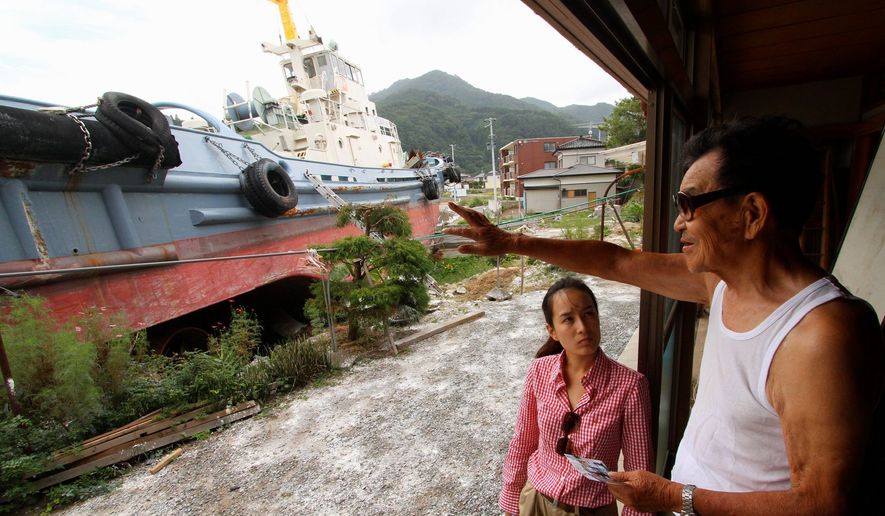OFUNATO, Japan — An elderly couple here are learning to live with a strange lawn ornament dumped in their front yard seven months ago in the tsunami that devastated Japan’s northeast coast.
A 230-ton tugboat that is high and wide enough to cast a shadow over their house has become a tourist attraction, but Kinichi Oikawa, 82, and his wife, Shizuko, 80, want the boat owner to get the vessel off their property.
But the owner of the Kazumaru No. 1 tugboat, which used to fight fires and haul massive freighters around the Ofunato harbor, cannot afford to move it.
“We never imagined that a boat from the ocean below would end up in front of our house,” said Mrs. Oikawa, whose home has acquired the nickname the “tugboat house.”
When the couple felt the magnitude 9.0 earthquake March 11, they remembered past tsunamis that hit Ofunato in 1933 and 1960. They immediately ran up a hill to high ground.
As they trudged through debris to reach their home the next morning, they saw the boat. It appeared to be floating in an inland sea of wreckage.
Their house was flooded up to the roof, and their possessions were scattered around their neighborhood or washed out to sea.
“I never thought nature could be that strong and destructive,” Mrs. Oikawa said, looking at the boat dwarfing a plant just a few feet in front of her living room.
The boat no longer leaks fuel or reeks of sea salt and barnacles, but it has become a haven for spiders, birds and a community of hardy critters.
It also is attracting dozens of gawkers every day who turn off Highway 45 and drive up a narrow street to see one of the most famous sites in the 300-mile tsunami disaster zone.
The tsunami, funneled by a narrow harbor into a 65-foot-high sea surge, pushed the tugboat about a mile up a slope, bashing houses along the way.
The tugboat stopped just inches from the front door of the Oikawas’ traditional Japanese-style wooden home.
The house remained intact in a town of 40,000 people where about 4,000 houses were destroyed and at least 400 are dead or missing.
Mrs. Oikawa believes the souls of her deceased relatives saved the house from the tugboat.
“Our ancestors must have protected all of us on that day because there were no casualties at all in our family,” she said as she dusted off a black-and-gold shrine near the home’s main entrance. “This is why we come to pray for our ancestors here every day.”
Mr. Oikawa, a former railway employee who lives off the company’s small monthly pension plus money sent by their son, said he would like to see the tugboat moved back to where it belongs in the port.
But city hall officials told him that the owner, Katsumi Yamaguchi, cannot afford the high cost of hiring a giant crane to move the vessel, and Mr. Yamaguchi’s insurance will not cover the full cost of removing a tugboat from a hillside neighborhood.
Some visitors to the Ofunato “tugboat house” have suggested that they leave the boat in their front yard as a memorial to the disaster to remind future generations to prepare for tsunamis that have devastated the local coast throughout history.
Many residents of Otsuchi, farther north up the coast, were disappointed when a shipowner removed a ferry famously perched atop a guest house.
Those residents had wanted the site to become a tsunami museum to attract thousands of tourists to help rebuild the local economy.
Mrs. Oikawa said she does not mind hosting visitors, especially younger people, who help to keep their spirits up.
“Thousands of people have come to see the boat in front of our house over the past six months, but it does not bother me. It is a chance for us to meet people from all over Japan,” she said.
“We are senior citizens, so we like to meet young people and all sorts of different people.”




Please read our comment policy before commenting.